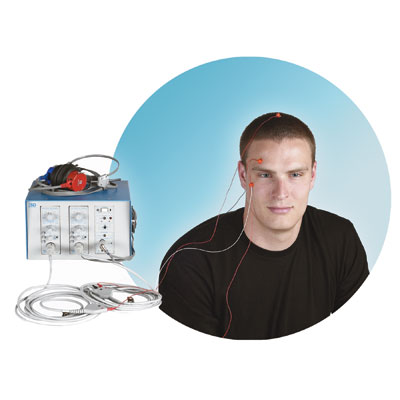Evoked potential studies measure electrical activity in the brain as a response to stimulation. This stimulus could be sound, touch, or sight and cause signals to move across nerves to the brain. In this article, we discuss key ways to detect and test evoked potential.
Visual Evoked Response (VER) Test
VER tests measure the electrical responses from the brain, diagnosing issues with optic nerves that impact sight. These tests involve healthcare professionals attaching electrodes to the scalp to keep track of the electrical signals in the brain.[1]
The test reliability varies between patients because of the range of skull thicknesses, electrode placement, and visual cortex morphology.
Visually evoked potential tests are usually recorded by putting the patient in front of a black and white checkerboard pattern shown on a video monitor. The pattern alternates, causing the patient’s visual system to produce an electrical response detectable using an electrode attached to the head.[2]
Another visual evoked potential test is the flash VEP. This test leads to electrical responses from the brain’s visual cortex and the variations come from the range of stimuli used. Instead of using a monitor as with the pattern VEP, a Ganzfeld stimulator is used, which is more suitable for unconscious or uncooperative patients.
Visual evoked potential tests can test for optic neuritis, optic nerve disorders, multiple sclerosis, unexplained visual acuity loss, pre-surgical evaluation, malingering, and pre-surgical evaluation.[3]
Brainstem Auditory Evoked Response Test (BAER)
This test is used to diagnose hearing problems, point to brainstem tumours and multiple sclerosis.[4] These tests measure how the brain processes sound, recording brainwaves in response to clicks and other auditory stimuli. This test is particularly useful for newborns and young children who aren’t able to participate in standard hearing tests. Brainstem auditory evoked potential tests are the only reliable way to test dog hearing abilities.[5]
Somatosensory Evoked Response Test (SSER)
This form of evoked potential test detects issues with the spinal cord that can lead to numbness in limbs. This test involves attaching an electrode to the back of the wrist or knee and administering mild electrical shocks.
Somatosensory evoked potential tests evaluate the health of peripheral nerves and the spinal cord. It is usually used when numbness, muscle weakness, or loss of vibration is occurring.[6]
ERP-Lab From San Diego Instruments

The ERP-Lab from San Diego Instruments is a system for studies of pre-identified areas of the brain. This product allows for simple and reliable evoked response testing, eliminating unnecessary hardware and allowing for easy setup.
The test involves the delivery of two tones via headphones to the subject. With just six electrodes the signals are recorded and saved for further analysis. SDI’s ERP-LAB is ideal for targeted testing of P50, P300 and Mismatch Negativity for research involving the pre- and attention-dependent cognitive effects of Alzheimer’s, schizophrenia and other brain abnormalities. Offering two-channel testing: EEG and EOG(for artifact detection), the SDI ERP-LAB is often called “ERP-Light” as it is an easy-to-use version of the traditional evoked response potential test system.
[1] Sensory Evoked Potentials Studies. (2022). Retrieved 1 March 2022, from https://www.hopkinsmedicine.org/health/treatment-tests-and-therapies/sensory-evoked-potentials-studies
[2] Electrodiagnostic Tests – LKC Technologies. (2022). Retrieved 1 March 2022, from https://lkc.com/applications/electrodiagnostic-tests/
[3] Electrodiagnostic Tests – LKC Technologies. (2022). Retrieved 1 March 2022, from https://lkc.com/applications/electrodiagnostic-tests/
[4] Sensory Evoked Potentials Studies. (2022). Retrieved 1 March 2022, from https://www.hopkinsmedicine.org/health/treatment-tests-and-therapies/sensory-evoked-potentials-studies
[5] BAER (Brainstem Auditory Evoked Response) Test. (2022). Retrieved 1 March 2022, from https://www.healthline.com/health/baer-brainstem-auditory-evoked-response
[6] BAER (Brainstem Auditory Evoked Response) Test. (2022). Retrieved 1 March 2022, from https://www.healthline.com/health/baer-brainstem-auditory-evoked-response